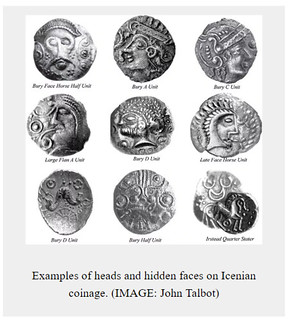
PREV ARTICLE
NEXT ARTICLE
FULL ISSUE
PREV FULL ISSUE
ICENIAN COINAGE STUDYHere's an excerpt from a great article in Current Archaeology about a study of Iron Age coinage. -Editor
It is often suggested that Iron Age coinage is not money in the modern sense of the word, being rather more analogous to prestige objects – used by societies in various forms of gift exchange – but there was little evidence known to support this theory. To address this question and hopefully learn more about the Iceni in the process, over the course of ten years I studied dies relating to over 10,000 coins. This enabled me to work out the organisation of the coinage, where previously there had been long lists of seemingly unconnected types – a process that not only provided a more in-depth and accurate chronology for the coins and how they developed over time, but also revealed more about the sophistication and nuance of the Icenian culture. I used computer graphics to superimpose photographs of one coin onto another; this allowed me to fade or cut through the top image to establish whether two coins were struck from the same die. Identification was further facilitated by developing a technique to provide composite images of coins struck by different parts of the same die. These images can help to reconstruct almost complete dies. Using these methods, the project identified almost 1,600 different Icenian official dies and several hundred Iron Age forgeries. Many of these formed long die-chains with a definitive internal chronology, and by comparing these to other evidence like hoard content and distribution, the organisation of Icenian coinage became clearer.
To read the complete article, see:

Wayne Homren, Editor The Numismatic Bibliomania Society is a non-profit organization promoting numismatic literature. See our web site at coinbooks.org. To submit items for publication in The E-Sylum, write to the Editor at this address: whomren@gmail.com To subscribe go to: https://my.binhost.com/lists/listinfo/esylum All Rights Reserved. NBS Home Page Contact the NBS webmaster 
|

